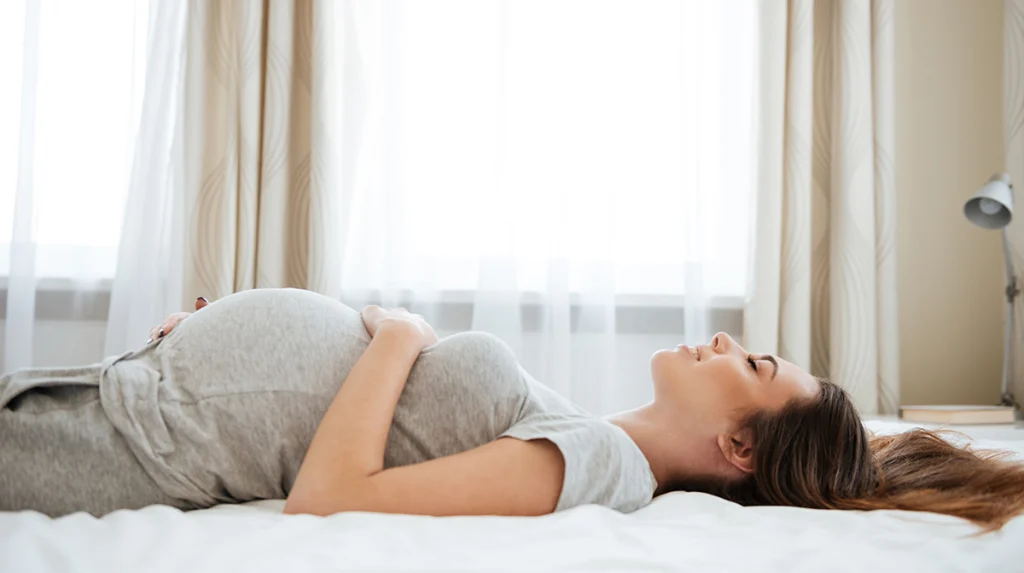
Uncomfortable sleeping while pregnant? Many pregnant women are struggling with this. As your body changes, traditional sleeping positions may no longer be suitable or comfortable. Factors such as increased weight, pressure on internal organs, and hormonal changes can all affect your sleep quality. Certain positions might pose risks to your baby’s well-being. Thus, it is essential to find the right way to rest.
We will explore the best safe sleeping positions while pregnant as well as offer practical tips to improve your sleep. Let us help you to achieve a restful and safe night’s sleep while pregnant.
What Is Better Side Sleeping While Pregnant: Left vs. Right

Doctors generally recommend sleeping on your side throughout pregnancy, especially in later trimesters before childbirth. As your baby grows, sleeping on your back (supine position) can put pressure on the major blood vessels carrying blood to your uterus. This could potentially reduce blood flow to your baby.
The raised question is whether the left or right sides are safe sleeping positions to sleep while pregnant. Let’s find out right away.
Benefits of Left-Side Sleeping
When it comes to pregnancy sleep positions, there’s a reason why doctors often recommend snoozing on your left side. Here’s why:
- Blood Flow Bonanza: Sleeping on your left side keeps the inferior vena cava (IVC), a major vein that carries blood to your heart and your little fetus, flowing freely. This unobstructed flow ensures optimal delivery of oxygen and nutrients to your little one.
- Good For Liver and Kidneys: Side sleeping also takes the pressure off your liver and kidneys, giving them more space to function properly. This can help reduce swelling issues like puffy hands, ankles, and feet – a common pregnancy struggle.
- So, snuggle up on your left side for a comfortable and healthy night’s rest, both for you and your growing baby!
Right-Side Sleeping: Is it good?
While sleeping on your left side offers blood flow benefits, sleeping on your right side is also considered safe. There might be a slight chance of blood vessel compression, but prioritize comfort.
Best Safe Sleeping Positions While Pregnant In Each Stage

Getting pregnant is a big happiness but also brings you a lot of problems. One of them is sleeping. Below are some ways how to sleep better in each pregnancy trimester.
In First Trimester
In this early stage, there’s no need to stress about specific sleep positions. Just sleep in the way that you find comfortable most.
You can try to slip a pillow between your legs for better hip and lower back comfort. This simple trick can make side sleeping more enjoyable.
In Second Trimester
As your baby grows, a supportive sleep environment becomes increasingly important. Here’s how to create your pregnancy sleep haven:
- Mattress Matter: A firm mattress helps prevent back pain by maintaining proper spinal alignment. If your current mattress is too soft, consider placing a supportive board underneath it.
- Pregnancy Pillow: Pregnancy pillows, often U- or C-shaped, provide full-body support for side sleepers. They cradle your back, offer a front hug for comfort, and cushion your knees for better alignment.
In Third Trimester
At this stage of pregnancy, your baby bump is really big and makes your sleeping time more uncomfortable. Here are some tips to maximize comfort during this time:
- Pregnancy Pillow: Continue using your trusty pregnancy pillow for full-body support.
- Wedge Pillow: If the pregnancy pillow feels bulky, consider wedge pillows. Place one under your belly and another behind your back to prevent rolling onto your back.
- Angled Comfort: Can’t quite manage full-side sleeping? Prop yourself up at a 45-degree angle with comfortable pillows. This semi-upright position takes the pressure off your IVC while avoiding flat-on-back sleeping.
- Head Elevation Hack: For an alternative approach, try elevating the head of your bed a few inches with books or blocks. This can also help improve blood flow and reduce pressure.
Sleeping Position To Avoid During Pregnancy?

While back and stomach sleeping is generally safe in the first trimester, it’s best to avoid it later in pregnancy. Here’s what you need to know:
Back Sleeping Position
- Potential Risks After 28 Weeks: A review of medical studies in 2019 suggests a possible link between consistent back sleeping after 28 weeks and a very slight increase in stillbirth risk. However, these studies are small, and other factors might be involved. However, not sleeping on your back may help to reduce the risk of stillbirth by 5.8%.1
- Additional Concerns: Back sleeping can also contribute to low back pain, hemorrhoids, heartburn, poor circulation, and obstructive sleep apnea. You might also experience lightheadedness and dizziness.
The risk of stillbirth from back sleeping is very low. It’s still recommended to prioritize side sleeping for optimal comfort and blood flow.
Don’t panic if you find yourself on your back occasionally. Gently shift to your side and go back to sleep. If you’re a back sleeper, consider using a wedge pillow positioned behind you. This can help prevent you from completely rolling onto your back and improve circulation.
Stomach Sleeping
Early pregnancy is a time of many adjustments, and sleep positions are no exception. Here’s what you need to know about stomach sleeping:
- Early On, It’s Okay: In the first trimester (between 1 to 12 weeks), stomach sleeping is safe for most expecting mothers. The uterus is still low in your pelvis, and the amniotic fluid cushions your baby.
- Growing Belly: However, as your belly grows, stomach sleeping will likely become uncomfortable. If you do find yourself on your stomach occasionally, don’t panic. The strong uterine walls and amniotic fluid protect your baby.
- Specialty Pillows: There are specially designed stomach sleeping pillows available. These pillows typically have a cutout for your belly, allowing for more comfort while still keeping you on your stomach.
If the stomach or back sleeping position is your favorite, you may find it a challenge to adjust. You can try side sleeping with one or both knees bent. This position can help to support your back for more comfortable sleeping.
Some Tips to Help You Sleep Better While Pregnant

A good night’s sleep is crucial during pregnancy, but finding comfort in pregnant sleeping positions can be a challenge. Here are some tips to help improve your pregnancy sleeping quality:
- Take a warm bath or sip a soothing herbal tea (check with your doctor first) before bed to signal to your body it’s time to wind down. A warm bath during pregnancy is helpful but don’t stay in too long
- Dim the lights, minimize noise distractions, and banish electronics from your bedroom.
- If you’re struggling to sleep through the night, schedule short naps earlier in the day to avoid impacting nighttime sleep.
- Practice relaxation techniques like deep breathing or meditation before bed to calm your mind and body.
- Opt for small, bland snacks like crackers to combat nausea without triggering heartburn.
- Consider taking prenatal vitamins, especially iron and folic acid. They may help alleviate restless legs syndrome, a common sleep disorder.
- Limit your intake of coffee, tea, and soda throughout the day, especially in the afternoon and evening, as caffeine can interfere with sleep.
Final Words
A good night’s sleep is vital for both you and your growing baby. While pregnancy can bring sleep challenges, prioritizing side sleeping with comfortable pillows. Besides, a relaxing bedtime routine can significantly improve your sleep quality. Remember, there’s no one-size-fits-all approach. Experiment with different safe sleeping positions while pregnant, listen to your body and don’t hesitate to discuss any concerns with your doctor.
Sources
- Silver RM;Hunter S;Reddy UM;Facco F;Gibbins KJ;Grobman WA;Mercer BM;Haas DM;Simhan HN;Parry S;Wapner RJ;Louis J;Chung JM;Pien G;Schubert FP;Saade GR;Zee P;Redline S;Parker CB; ; Prospective evaluation of maternal sleep position through 30 weeks of gestation and adverse pregnancy outcomes, Obstetrics and gynecology. Available at: https://pubmed.ncbi.nlm.nih.gov/31503146/ (Accessed: 22 June 2024) ↩︎






